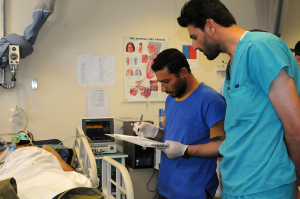By Karon Fowler
Last week in FTC v. Kristy Ross, the Fourth Circuit ruled on a Federal Trade Commission (“FTC”) suit against Kristy Ross, a leader at Innovative Marketing, Inc. (“IMI”), for running a deceptive internet “scareware” scheme in violation of § 5(a) of the Federal Trade Commission Act (“FTCA”). The “scareware” scheme relies on advertisements that tell consumers that a scan of their computers had been performed and a variety of dangerous files, such as viruses and spyware, had been detected. However, no scans were actually conducted and instead simply “trick[ed] consumers into purchasing computer security software.”
The district court entered summary judgment in favor of the Commission on the issue of whether the advertising was deceptive, but it set a separate trial to determine whether Ross could be held individually liable under the FTCA as a “control person” at the company and to what extent she had authority over and knowledge of IMI’s deceptive acts. The district court concluded that Ross had actual knowledge of the deceptive marketing scheme, or was “at the very least recklessly indifferent or intentionally avoided the truth” about the scheme. It entered judgment against Ross in the amount of $163,167,539.95, and it enjoined her from engaging in similar deceptive marketing practices.
Ross appealed the district court judgment on four bases: (1) the court’s authority to award consumer redress; (2) the legal standard the court applied in finding individual liability under the Federal Trade Commission Act; (3) the court’s prejudicial evidentiary rulings; and finally, (4) the soundness of the district court’s factual findings.
The court’s authority to award consumer redress
Although the FTCA’s test does not expressly authorize the award of consumer redress, the Supreme Court has long held that when Congress invokes the federal district court’s equitable jurisdiction, it provides the court with the power to decide all relevant matters in dispute and to award complete relief. This is true even where the decree includes that which might be conferred by a court of law. The court explains that Supreme Court precedent sets forth the presumption that Congress, by statutorily authorizing the exercise of the district court’s injunctive power, it also acted with awareness of the historic power of equity to provide complete relief. This complete relief may necessarily include consumer redress. Thus, absent some countervailing indication sufficient to rebut the presumption, the court had sufficient statutory power to award “complete relief” under the FTCA, including monetary consumer redress—a form of equitable relief.
The court explained that although Ross made some strong arguments about the structure, history, and purpose of the FTCA, her arguments have been rejected by every other federal appellate court to have considered the issue. Those cases can be found here: F.T.C. v. Bronson Partners LLC, 654 F.3d 359, 365-67 (2d Cir. 2011);F.T.C. v. Amy Travel Service, Inc., 875 F.2d 564, 571 (7th Cir. 1989); F.T.C. v. Security Rare Coin & Buillion Corp., 931 F.2d 1312, 1314-15 (8th Cir. 1991); F.T.C. v. Pantron I Corp., 33 F.3d 1088, 1101-02 (9th Cir. 1994); F.T.C. v. Gem Merchandising Corp., 87 F.3d 466, 468-70 (11th Cir. 1996).
The legal standard applied in finding individual liability under the FTCA
Below, the district court rules that individual liability can be found where the individual (1) participated directly in the deceptive practices or had authority to control them, and (2) had knowledge of the deceptive conduct, which could be satisfied by showing evidence of actual knowledge, reckless indifference to the truth, or an awareness of a high probability of fraud combined with intentionally avoiding the truth (i.e., willful blindness).
Ross attacked this standard and instead asked the court to utilize a different standard found in securities fraud cases that requires an individual to have (1) “authority to control the specific practices alleged to be deceptive,” coupled with a (2) “failure to act within such control authority while aware of apparent fraud.” See, e.g.,Dellastatious v. Williams, 242 F.3d 191, 194 (4th Cir. 2001). The court rejected this proposal because it would make most FTC charges “futile” against individuals responsible for illegal practices by way of their control over “the lifeless entity of a corporation.” In other words, the standard should reflect the fact that individuals are responsible for implementing these deceptive practices and a requirement of actual awareness would thwart the goal of personal accountability.
The Fourth Circuit held that an individual may be liable under the Federal Trade Commission Act (FTCA) if he or she (1) participated directly in the deceptive practicesor had authority to control those practices, and (2) had or should have had knowledge of the deceptive practices. The second prong may be satisfied by showing that the individual had actual knowledge of the deceptive conduct, was recklessly indifferent to its deceptiveness, or had an awareness of a high probability of deceptiveness and intentionally avoided learning the truth.
Moreover, a ruling in Ross’ favor would create a serious circuit split—a result the Fourth Circuit would rather avoid. Every federal appellate court to have heard the issue has adopted the same two-prong test. Those cases can be found here: F.T.C. v. Direct Marketing Concepts, Inc., 624 F.3d 1, 12 (1st Cir. 2010); Amy Travel Service, 875 F.2d at 573-74; F.T.C. v. Publishing Clearing House, Inc., 104 F.3d 1168, 1170 (9th Cir. 1997); F.T.C. v. Freecom Communications, Inc., 401 F.3d 1192, 1207 (10th Cir. 2005); Gem Merchandising Corp., 87 F.3d at 470.
The three evidentiary challenges
(1) Ross argued that the district court improperly precluded her expert from testifying about how “the advertisements linkable to Ms. Ross’s responsibilities were nondeceptive.” Yet, the district court had already decided the deceptiveness issue in favor of the Commission at the summary judgment stage. The only at issue at trial was whether Ross had the required degree of control to hold her individually liable for the company’s practices. Because the individual liability standard does not require a specific link from Ross to particular deceptive advertisements and instead looks at whether she had authority to control the corporate entity’s practices, Ellis’ testimony was immaterial, and thus irrelevant, to the issue reserved for trial. FRE 401.
(2) Ross contended that the district court erred in admitting and relying on a 2004 to 2006 profit and loss statement to calculate the amount of consumer redress. The statement was admitted under FRE 807 (the residual exception to the rule against hearsay), the Fourth Circuit explained that it may affirm the district court on the basis of any independent ground supported by the record. The court thus concluded that the profit and loss statement was admissible under FRE 801(d)(2)(B) as an adoptive admission by Ross. Ross expressly adopted the statement by agreeing with an original co-defendant’s affidavit that provided the statement as an attachment.
(3) Ross finally argued that there was insufficient evidence establishing a predicate for an email between individuals within the company to be admitted for the existence of the conspiracy under FRE 801(d)(2)(E). Ross contended that the admission of the email constituted “bootstrapping” of the existence of the conspiracy to the document’s admissibility. The court disagreed. Based on Fourth Circuit precedent, the proponent for admission of a co-conspirator’s out-of-court statement must demonstrate the existence of the conspiracy by evidence extrinsic to the hearsay exception. Here, however, that requirement was satisfied because Ross produced an affidavit during the corporate litigation in which she stated she was a Vice President and co-founder of IMI, choosing to adopt the affidavits of her co-defendants attesting to the same facts. This evidence, along with the email mentioned in the second evidence issue, provided a sufficient basis upon which the district court could conclude the existence of a conspiracy.
The “authority to control” issue
Ross lastly argued that the district court clearly erred in finding she had “control” of the company, participated in any deceptive acts, and had knowledge of the deceptive advertisements. Because it was a bench trial below, the Fourth Circuit reviewed the court’s factual findings for clear error and its legal conclusions de novo. In an affidavit in the corporate litigation, Ross swore she was a high-level business official with certain duties that provided the district court with sufficient evidence of her authority and control over the nature and quality of the advertisements. Moreover, Ross’ statements to other employees, as memorialized in chat logs between her and other employees, were evidence that she served in a managerial role, directing the design of particular advertisements. Her extensive involvement indicated in the record provided fertile ground for the district court to reasonably infer that Ross was actively and directly participating in the multiple states of the deceptive advertising scheme. As to the “actual knowledge” or “reckless indifferen[ce]” finding, the court explained that Ross acted in a way to suggest she may not have personally believed the advertisements were deceptive, Ross was clearly on notice of the various complaints received by IMI, including that they would cause consumers to automatically download their products.
The Fourth Circuit thus affirmed the district court on all issues.









